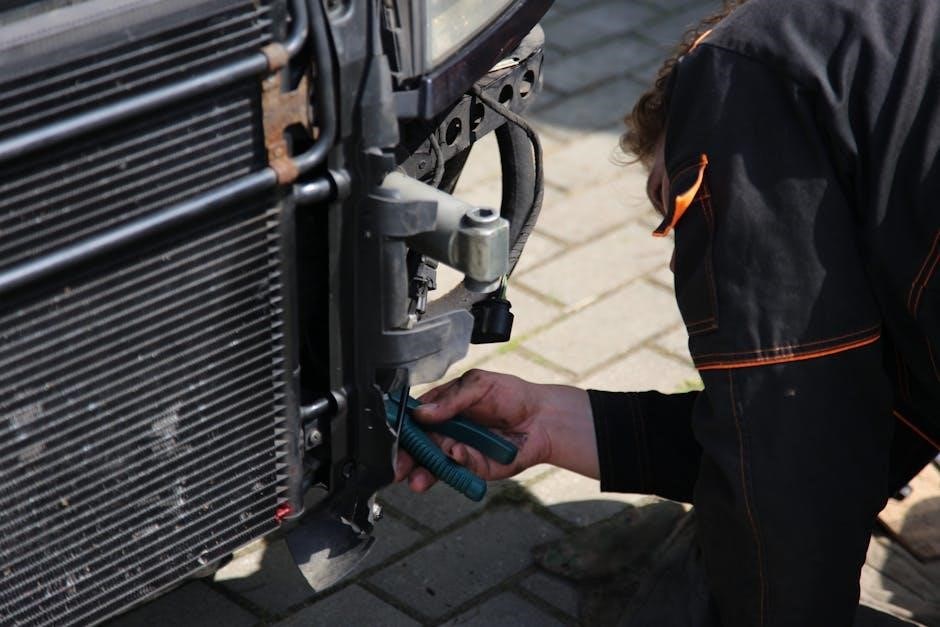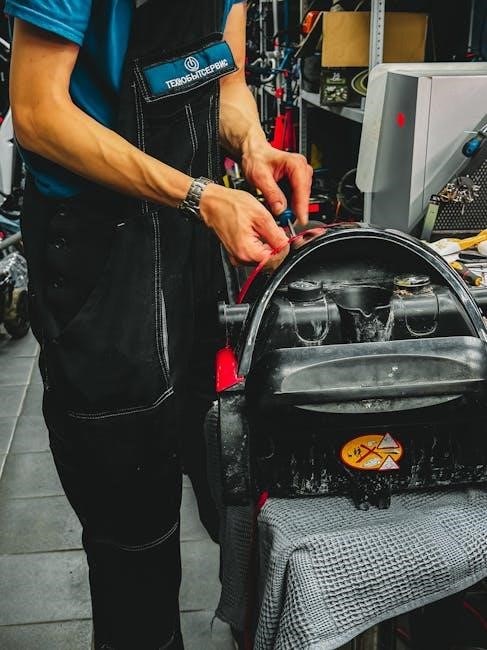A manual gearbox flush involves replacing the old transmission fluid with fresh lubricant to maintain smooth gear operation and prevent wear. Regular flushing ensures optimal performance.
1.1 What is a Manual Gearbox Flush?

A manual gearbox flush is a maintenance procedure where the old transmission fluid in a vehicle’s manual gearbox is drained and replaced with fresh lubricant. This process is essential for ensuring smooth gear operation and preventing wear on the gearbox components. The gearbox fluid, which is typically a specific type of gear oil, plays a crucial role in lubricating the gears, reducing friction, and preventing overheating. Over time, this fluid can become contaminated with debris and degrade, leading to rough shifting and potential damage to the gears. Regular flushing helps maintain optimal performance and extends the lifespan of the gearbox. It is not the same as changing engine oil, as it requires specific tools and knowledge. The flush involves draining the old fluid, cleaning the system, and refilling it with the appropriate new fluid. While it can be done by a DIYer with the right tools, it’s often recommended to consult a professional to ensure it’s done correctly. Regular flushing is a preventive measure that can prevent costly repairs and ensure the gearbox operates smoothly for years. Signs that a flush may be needed include difficulty shifting gears or decreased performance. Typically, manufacturers recommend flushing the gearbox fluid at specific intervals, such as every 30,000 to 60,000 miles, depending on driving conditions. Understanding and performing this procedure correctly is vital for maintaining the health of a vehicle’s manual transmission system.
1.2 Importance of Regular Gearbox Maintenance
Regular gearbox maintenance is crucial for ensuring the longevity and smooth operation of a vehicle’s manual transmission. Over time, gearbox components can wear down due to friction, heat, and contamination, leading to costly repairs if left unaddressed. By maintaining the gearbox, drivers can prevent premature wear, reduce the risk of mechanical failure, and ensure smooth shifting. Clean gearbox fluid plays a vital role in lubricating gears and preventing overheating. Neglecting maintenance can result in rough shifting, difficulty engaging gears, and eventual gearbox failure. Regular upkeep helps maintain optimal performance, reduces the risk of breakdowns, and extends the lifespan of the transmission. Consistent care ensures reliability and peak functionality, making it a critical part of vehicle ownership.

Benefits of a Manual Gearbox Flush
A manual gearbox flush offers numerous advantages, including improved performance, extended lifespan, and prevention of damage. It ensures smoother shifting, reduces wear on components, and enhances driving experience.
2.1 Improved Gearbox Performance
A manual gearbox flush significantly enhances performance by removing contaminants and worn-out fluid. This ensures smoother gear shifting and reduces friction between components. Fresh fluid improves lubrication, leading to quieter operation and more precise control. Over time, old fluid can degrade, causing gears to wear and shift less smoothly. Flushing the system restores optimal performance, making driving more responsive and enjoyable. Regular flushes help maintain the gearbox’s efficiency, preventing the buildup of debris that can hinder its function. By keeping the system clean, you ensure reliable operation and reduce the risk of mechanical issues. This maintenance step is crucial for maintaining the gearbox’s health and performance over time.
2.2 Extended Gearbox Lifespan
A manual gearbox flush plays a crucial role in extending the lifespan of your transmission. Over time, the gearbox fluid degrades and accumulates contaminants, which can cause premature wear on gears and bearings. Flushing the system removes these harmful particles and replaces the old fluid with fresh lubricant, ensuring proper gear lubrication. This reduces friction and wear, allowing components to last longer. Regular flushes prevent the buildup of sludge and debris, which can lead to costly repairs if left unchecked. By maintaining clean and high-quality fluid, you protect the gearbox from premature aging and ensure it operates smoothly for years. This proactive maintenance is essential for maximizing the transmission’s lifespan and reliability.
2.3 Prevention of Gearbox Damage
A manual gearbox flush is a vital maintenance procedure that helps prevent damage to the transmission system. Over time, contaminants like dirt, metal shavings, and degraded fluid can accumulate inside the gearbox, leading to increased wear on gears and bearings. If left unchecked, this can result in costly repairs, such as replacing damaged components or even the entire gearbox. By flushing the system, you remove these harmful particles and replenish the fluid, ensuring proper lubrication and cooling. This proactive approach prevents overheating, reduces friction, and safeguards against premature wear. Regular flushes are essential to maintain the health and functionality of your manual gearbox, avoiding potential breakdowns and extending its operational life.

When to Perform a Manual Gearbox Flush
A manual gearbox flush should be performed at intervals recommended by the manufacturer, typically every 30,000 to 60,000 miles, depending on driving conditions.
3.1 Signs Your Gearbox Needs a Flush
Identifying when your manual gearbox needs a flush is crucial for maintaining its health. Common signs include dark or dirty transmission fluid, unusual grinding or whining noises, and difficulty shifting gears. If the gearbox feels sluggish or hesitates during acceleration, it may indicate contaminated fluid. Additionally, if you notice metal shavings in the fluid or a burning smell, it’s a clear sign that a flush is overdue. Regularly checking the fluid’s condition can help you catch these issues early. Ignoring these signs can lead to premature wear and costly repairs. Always address these indicators promptly to ensure smooth operation and longevity of your gearbox.

3.2 Manufacturer Recommendations
Manufacturer recommendations for a manual gearbox flush vary by make and model, but most suggest regular intervals for optimal performance. Typically, this ranges from every 30,000 to 60,000 miles, depending on driving conditions. Consulting your vehicle’s service manual is essential to follow specific guidelines. Some manufacturers may advise flushing the gearbox fluid every time you change the engine oil, while others recommend it less frequently. Adhering to these schedules helps maintain warranty validity and ensures the gearbox operates within designed specifications. Ignoring manufacturer advice can lead to reduced gearbox lifespan and potentially void warranties. Always prioritize these recommendations to keep your manual transmission running smoothly and reliably.

Tools and Materials Needed
To perform a manual gearbox flush, you’ll need a socket set, drain pan, new gearbox fluid, filter (if applicable), and rags for cleaning. Ensure all materials are compatible with your vehicle’s specifications.
4.1 Essential Tools for the Job
Performing a manual gearbox flush requires specific tools to ensure the process is done safely and effectively. A torque wrench is essential for properly tightening bolts. You’ll also need a drain pan to catch the old fluid, a socket set for removing the drain plug, and a ratchet for easy bolt removal. Additionally, a pair of wrenches (adjustable and box-end) can help with various connections. A cleaning brush and funnel are useful for cleaning and refilling the gearbox. Having a service manual for your vehicle is highly recommended to ensure you follow the correct procedures and torque specifications. These tools will help you complete the flush efficiently and avoid potential damage to your gearbox.
4.2 Recommended Gearbox Fluids
Choosing the right gearbox fluid is crucial for optimal performance and longevity. Mineral-based oils are commonly used for manual gearboxes due to their excellent lubrication properties and affordability. Synthetic oils, while more expensive, offer superior performance in extreme temperatures and provide better wear protection. semi-synthetic oils strike a balance between cost and performance. Popular brands include Castrol, Valvoline, and Red Line. Always consult your vehicle’s service manual to ensure compatibility. Using the wrong fluid can lead to poor shifting, increased wear, or even gearbox failure. High-quality fluids are designed to reduce friction, prevent corrosion, and maintain viscosity under varying conditions, ensuring smooth and reliable gear operation.

Step-by-Step Guide to a Manual Gearbox Flush
This section outlines the process of flushing your manual gearbox, from preparation to completion. Follow these steps carefully to ensure a successful and clean fluid replacement.
5.1 Preparing the Vehicle
Before starting the flush, ensure the vehicle is on level ground and apply the parking brake. Gather all necessary tools and materials, including drain pans, socket wrenches, and new gearbox fluid. Warm up the engine by driving for a few minutes to circulate the fluid. Locate the gearbox drain plug, typically found at the bottom of the transmission. Protect the surrounding area with newspaper or a large drip pan to catch any spills. Finally, ensure all safety precautions are in place, such as wearing gloves and safety glasses, before proceeding with the flush.
5.2 Draining the Old Gearbox Fluid
To drain the old gearbox fluid, locate the drain plug, usually at the bottom of the transmission. Use a socket wrench to remove the plug slowly. Be prepared for the fluid to flow out quickly, so have a drain pan in place. Allow the fluid to completely drain before replacing the plug; Tighten the drain plug to the manufacturer’s specified torque to avoid stripping the threads. Inspect the fluid’s color and consistency; dark or gritty fluid indicates contamination. Dispose of the used fluid responsibly. Once drained, proceed to the next step of cleaning the gearbox system.
5.3 Cleaning the Gearbox System
After draining the old fluid, clean the gearbox system thoroughly. Use a gearbox cleaning solution or a solvent to flush out any debris, dirt, or old fluid residue. Ensure all internal components are free from contaminants by circulating the cleaning solution through the system. Allow the solution to flow through the gearbox for a few minutes before draining it completely. Inspect the drained cleaning solution for any remaining contaminants. Repeat the process if necessary until the solution runs clean. Once satisfied, proceed to refill the gearbox with fresh, high-quality transmission fluid. Proper cleaning ensures the new fluid performs optimally and prolongs gearbox life.
5.4 Refilling with New Gearbox Fluid
Once the system is clean, carefully refill the gearbox with new fluid. Use a fluid that meets or exceeds the manufacturer’s specifications. Avoid overfilling, as this can lead to excessive pressure and potential damage. Pour the fluid slowly, checking the level periodically with the dipstick or filler plug. Ensure the vehicle is on a level surface for an accurate reading. Replace the filler plug securely and start the engine, allowing it to run in neutral for a few minutes. This helps circulate the new fluid throughout the system. Finally, check for any leaks around the filler plug and verify the fluid level again. Proper refilling is crucial for maintaining smooth operation and preventing premature wear. Always refer to your vehicle’s manual for specific guidance.
5.5 Checking for Leaks
After refilling the gearbox fluid, it’s essential to check for any leaks. Start by placing the vehicle on a level surface and gathering a drip pan and rag. Turn on the engine and let it run in neutral for a few minutes to circulate the new fluid. Shift through all gears slowly to pressurize the system, ensuring any potential leaks are revealed. Turn off the engine and inspect the drain plug, filler plug, and gearbox casing for signs of fluid seepage. Use a flashlight to examine hard-to-reach areas. If you notice any leaks, tighten the plugs or replace worn gaskets. Always clean the area first to avoid misidentifying old stains as new leaks. Addressing leaks promptly prevents further damage and ensures the flush is effective. Never drive the vehicle if a leak is detected.

Tips for Maintaining Your Manual Gearbox
Regular maintenance, including fluid changes and inspections, ensures smooth operation and longevity of your manual gearbox. Proper driving habits and timely repairs contribute to its durability.
6.1 Choosing the Right Gearbox Fluid
Selecting the appropriate gearbox fluid is crucial for optimal performance. Always refer to your vehicle’s manufacturer specifications to ensure compatibility. The wrong fluid can damage seals or gears. Synthetic fluids are often recommended for better lubrication and temperature resistance. Check the viscosity level to match your gearbox’s requirements. Avoid mixing different types of fluids, as this can degrade performance. If unsure, consult your owner’s manual or a trusted mechanic. Using the correct fluid ensures smooth shifting, reduces wear, and extends the lifespan of your manual gearbox. Proper fluid selection is a cornerstone of effective gearbox maintenance.
6.2 Regular Inspection of Gearbox Components
Regular inspection of gearbox components is essential for maintaining performance and identifying potential issues early. Check for signs of wear, leaks, or damage on seals, gaskets, and hoses. Inspect the condition of the gear synchronizers, bearings, and shafts for any unusual wear or scoring. Ensure all mounting points are secure and free from rust. Monitor the gear engagement smoothness during drives, as hesitation or grinding could indicate internal wear. Always refer to your vehicle’s owner’s manual for specific inspection points. Regular checks can help prevent costly repairs and ensure your manual gearbox operates smoothly. Catching issues early enhances reliability and extends component lifespan.
6.3 Avoiding Harsh Driving Conditions
Avoiding harsh driving conditions is crucial for maintaining the health of your manual gearbox. Extreme temperatures, rough roads, and aggressive driving can strain the gearbox components. Sudden accelerations, frequent stop-and-go traffic, and towing heavy loads increase wear on gears and bearings. To minimize damage, drive smoothly and avoid extreme conditions when possible. Parking in shaded areas during hot weather can reduce heat exposure. Regular maintenance, including gearbox flushes, helps mitigate the effects of unavoidable harsh conditions. By being mindful of driving habits and environmental factors, you can protect your gearbox and ensure its extended lifespan.

Common Mistakes to Avoid
Common mistakes during a manual gearbox flush include using the wrong fluid, not following manufacturer guidelines, and skipping post-flush leak checks. Avoid these errors for optimal results.
7.1 Using the Wrong Type of Fluid

Using the incorrect gearbox fluid is a common mistake that can lead to poor lubrication and increased wear on internal components. Always select a fluid that meets the manufacturer’s specifications, as different gearboxes require specific viscosities and additives. Using the wrong fluid can cause friction issues, overheating, and even premature failure of synchronizers or gears. Consult your vehicle’s manual to ensure compatibility and avoid mixing fluids, as this can degrade their performance. Remember, the right fluid ensures smooth shifting, reduces wear, and prolongs gearbox life. Never assume all gearbox fluids are interchangeable—this is a critical error to avoid for optimal results.
7.2 Not Following the Manufacturer’s Instructions
Ignoring the manufacturer’s guidelines during a manual gearbox flush can lead to improper techniques, such as inadequate fluid removal or using unsuitable tools. Improper flushing might leave contaminants behind, risking gearbox damage. Using non-recommended materials can harm components, while incorrect torque specifications may cause leaks or improper sealing. Deviating from instructions can also result in using the wrong fluid type or quantity, leading to poor lubrication and increased wear on gears and synchronizers. This can cause shifting issues, noises, and reduced gearbox lifespan. Always adhere to manufacturer recommendations to ensure safety, efficiency, and longevity of your manual gearbox. Neglecting these guidelines can lead to costly repairs and undermine the benefits of the flush.
7.3 Overlooking Leak Checks
Overlooking leak checks after a manual gearbox flush can lead to fluid loss and reduced lubrication, causing premature wear on gears and bearings. Leaks often occur at the drain plug, pan bolts, or gasket surfaces. Ignoring these issues can result in contamination from dirt or debris entering the system. Over time, this can cause corrosion, overheating, and eventual gearbox failure. Regular leak inspections are essential to ensure the system remains sealed and functioning properly. Failing to address leaks can lead to costly repairs, such as replacing damaged components or even the entire transmission. Always perform a thorough leak check after refilling the gearbox fluid to maintain its integrity and performance.
A manual gearbox flush is a vital maintenance task that ensures smooth operation and prolongs gearbox lifespan. Regular flushing and proper care are key to avoiding costly repairs and maintaining performance.
8.1 Recap of Key Points
A manual gearbox flush is essential for maintaining optimal performance and longevity. It involves draining old fluid, cleaning the system, and refilling with the correct lubricant. Regular flushing prevents wear, reduces friction, and ensures smooth gear shifts. By following manufacturer guidelines and using the right tools, you can avoid common mistakes like using incorrect fluids or overlooking leak checks. Proper maintenance not only enhances driving experience but also prevents costly repairs. Consistency in upkeep and awareness of signs like grinding noises or sluggish response are vital. Remember, a well-maintained gearbox contributes to overall vehicle reliability and efficiency, making regular flushes a worthwhile investment.
8.2 Final Thoughts on Gearbox Maintenance
Consistent and proper maintenance of your manual gearbox is crucial for its longevity and performance. Regular flushes, inspections, and fluid changes are key to preventing wear and tear. Neglecting these steps can lead to costly repairs and premature failure. By staying proactive and following manufacturer guidelines, you can ensure smooth operation and reliability. Remember, a well-maintained gearbox not only enhances driving experience but also protects your investment. Always prioritize quality fluids and avoid shortcuts to maintain optimal functionality. Regular flushes are a simple yet effective way to keep your gearbox running like new for years to come.
